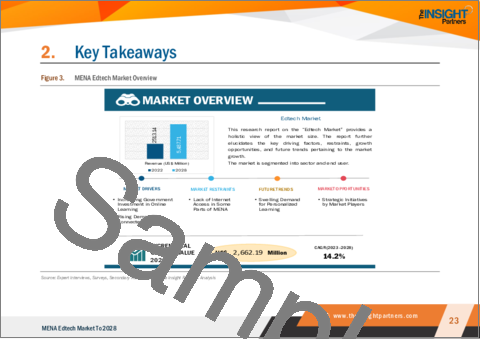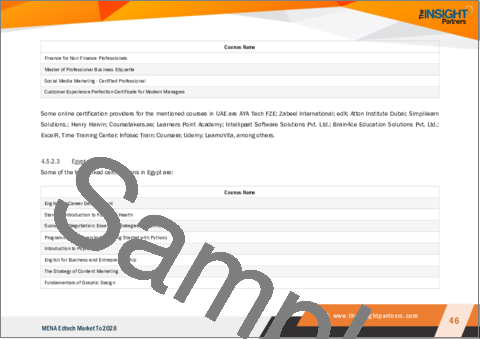|
|
市場調査レポート
商品コード
1296777
EdTechの中東・北アフリカ市場の2028年までの予測- 分野別、エンドユーザー別の地域分析MENA Edtech Market Forecast to 2028 - Regional Analysis by Sector (K-12, Higher Education, Pre-School, and Others) and End User (Individual, Academic Institutions, and Others) |
||||||
|
|||||||
| EdTechの中東・北アフリカ市場の2028年までの予測- 分野別、エンドユーザー別の地域分析 |
|
出版日: 2023年06月15日
発行: The Insight Partners
ページ情報: 英文 153 Pages
納期: 即納可能
|
- 全表示
- 概要
- 図表
- 目次
中東・北アフリカのEdTech市場は、2022年の25億米ドルから2028年には55億米ドルに成長すると予想されており、2023年から2028年までのCAGRは14.2%と推定されています。
COVID-19の発生以来、オンライン学習プログラムの需要が増加しています。従来の教育方法ではなく、遠隔学習を容易にする教育プラットフォームに人口が傾斜しています。さらに、パンデミックへの対応として、この地域ではオンライン教育プラットフォームに対する政府の受け入れが増加しています。中東・北アフリカ地域の各国政府は、オンライン学習を強化するために複数のイニシアチブを取っています。例えば、UAE政府はエミレーツ赤新月社と提携し、2023年2月に開催された世界政府サミット2023において、米国2,722万米ドル(1億AED)を投じてデジタル・スクール基金を設立しました。このパートナーシップを通じて、政府はデジタル・スクールのプログラムを財政的に支援し、災害や危機に見舞われたさまざまな国で、正規教育に関連するスマートで柔軟な遠隔教育システムを提供することを目指しています。したがって、政府によるこのようなイニシアチブは、予測期間中の中東・北アフリカEdTech市場の成長を促進すると思われます。
さらに、さまざまな主要世界市場プレーヤーが、この地域でオンライン学習プロジェクトを立ち上げています。例えば、KITMEKは2023年1月、AIベースの家庭教師が指導する中東初の双方向デジタルスクールを開始しました。幼稚園から5年生までの生徒は、このプラットフォームを通じて、月々わずか1米ドルで世界なカリキュラムにアクセスできます。また、この取り組みを通じて、子どもたちは自分のペースで学習や復習ができ、都合の良いときにどんなトピックでも再確認することができます。同様に、2022年3月、BYJUとカタール投資庁(QIA)は、ドーハに新たなEdTechビジネス、研究開発センターを立ち上げる覚書に調印しました。この新センターは、中東・北アフリカ地域の児童・生徒にカスタマイズされた学習ソリューションを提供するための研究と革新プログラムに取り組みます。市場プレーヤーが導入するこのような新しい学習ソリューションは、中東・北アフリカEdTech市場の成長をさらに促進すると思われます。
パーソナライズされた学習とは、生徒のニーズや能力に応じて学習体験をカスタマイズし、学習意欲や学習成果を向上させることを意図した学習者中心のアプローチです。この学習方法は、目標を設定し、進捗状況を追跡し、学習を振り返るのに役立つため、生徒の積極的な参加を促します。また、このプロセスは、学習者の関心に応じてコースが設計されるため、より高い学習継続率やより良い評価など、より良い学習成果をもたらします。さらに、パーソナライズド・ラーニングでは、学習者が自分のペースやスケジュールに合わせてコースにアクセスできるため、多忙なスケジュールでもさまざまな科目を学習することができます。上記のような利点があるため、さまざまな市場プレーヤーがパーソナライズされた学習体験を顧客に提供しています。2023年4月、Courseraは、パーソナライズされたインタラクティブなオンライン学習を顧客に提供するための新しいプラットフォーム・ツールと機能の立ち上げを発表しました。これらの新しいツールや機能は、Coursera Coach Powered by Generative AI、ML-Powered Translations、Flexible Viewing in Guided Projectsであり、顧客によりパーソナライズされた学習を提供します。このように、パーソナライズされた学習に対する需要の高まりと、市場プレーヤーによるこのアプローチの採用の増加は、予測期間中の中東・北アフリカEdTech市場の成長を促進すると思われます。
Udemy, Inc.、Coursera Inc.、Blackboard Inc.、Duolingo、edX LLCなどは、この市場調査で紹介されている中東・北アフリカEdTech市場のプレーヤーです。Almentor FZCO、Sololearn Inc、Zendy Institute、Noon Academy、Beams International LLC(Baims)などは、本レポートで紹介されているその他の注目すべき中東・北アフリカEdTech市場企業です。
EdTech市場の主なエンドユーザーには、個人、学術機関、その他が含まれます。2022年には、個人セグメントが最大のシェアを占め、EdTech市場で最も急成長しているセグメントです。効率的な学習、学習意欲の向上、オンライン教材への24時間アクセスなどが、エンドユーザーの間でのEdTech需要の拡大を後押ししています。
COVID-19パンデミックが中東・北アフリカEdTech市場に与える影響
COVIDの流行は中東・北アフリカEdTech市場に好影響を与えています。中東・北アフリカでは、COVID-19パンデミックの初期段階からオンライン教育への需要が急増したため、複数の高等教育プロバイダーがオンライン学位プラットフォームやコースを増加させました。Al-Fanar Mediaのレポートによると、Courseraは2020年3月中旬以降、中東・北アフリカからのオンライン学習者が500%増加しました。現在、Courseraの中東・北アフリカにおける学習者数は約340万人です。また、2020年3月には、オンラインコースを提供するFutureLearnが、中東・北アフリカからの参加者が500%増加したと報告しています。同様に、edXの地域別受講者数は2020年3月以降200%以上増加しています。HP Inc.も2021年5月にデジタル教育、包括的、学習プログラムを開始しました。これらのeラーニング・プログラムは、生徒の評価結果や総合的な成績の向上に役立っています。このように、中東・北アフリカ諸国では2021年半ばにオンライン教育が大幅に増加しており、この地域のEdTech市場に計り知れない可能性があることを示しています。
目次
第1章 イントロダクション
第2章 キーポイント
第3章 調査手法
- カバー範囲
- 2次調査
- 1次調査
- 市場分析において考慮した主な情報源と要因
- 主な二次情報源
- 考慮した主な要因
第4章 EdTech市場情勢
- 市場概要
- PEST分析
- 中東・アフリカ
- エコシステム分析
- 専門家の見解
- 重要考察
- 中東・北アフリカ競合試験分析
- サウジアラビア
- アラブ首長国連邦
- エジプト
- カタール
- クウェート
- モロッコ
- オマーン
- バーレーン
- 中東・北アフリカ資格認定分析
- サウジアラビア
- アラブ首長国連邦
- エジプト
- カタール
- クウェート
- モロッコ
- オマーン
- バーレーン
- 中東・北アフリカInternational Computer Driving License (ICDL)
- 中東・北アフリカ主要新興企業分析
- 中東・北アフリカ競合試験分析
第5章 EdTech市場:主要市場力学
- 市場促進要因
- オンライン学習への政府投資の増加
- コネクテッドデバイスに対する需要の高まり
- 主な市場抑制要因
- 中東・北アフリカ地域のインターネットアクセス不足
- 主な市場機会
- 市場プレイヤーの戦略的取り組み
- 今後の動向
- 個別学習への需要の高まり
- 促進要因と抑制要因の影響分析
第6章 EdTech市場の地域分析
- 中東・北アフリカEdTech市場概要
- 市場のポジショニング-主要5社
第7章 EdTech市場分析:分野別
- EdTech市場:分野別(2022年、2028年)
- K-12
- 高等教育
- 就学前教育
- その他
第8章 EdTech市場分析:エンドユーザー別
- EdTech市場:エンドユーザー別(2022年、2028年)
- 個人
- 学術機関
- その他
第9章 中東・北アフリカEdTech市場:地域分析
- 中東・北アフリカEdTech市場:国別
第10章 中東・北アフリカEdTech市場へのCOVID-19パンデミックの影響
第11章 業界情勢
- 市場イニシアティブ
- 新製品開発
第12章 企業プロファイル
- Almentor FZCO
- Udemy Inc
- Duolingo Inc
- Blackboard Inc.
- Sololearn Inc
- Zendy Institue
- Noon Academy
- Coursera Inc
- edX LLC
- Beams International LLC(Baims)
第13章 付録
List Of Tables
- Table 1. MENA Edtech Market - Revenue and Forecast to 2028 (US$ Million)
- Table 2. MENA Edtech Market, Revenue and Forecast To 2028 - By Country (US$ Million)
- Table 3. UAE Edtech Market, Revenue and Forecast to 2028 - By Sector (US$ Million)
- Table 4. UAE Edtech Market, Revenue and Forecast to 2028 - By End User (US$ Million)
- Table 5. Saudi Arabia Edtech Market, Revenue and Forecast to 2028 - By Sector (US$ Million)
- Table 6. Saudi Arabia Edtech Market, Revenue and Forecast to 2028 - By End User (US$ Million)
- Table 7. Egypt Edtech Market, Revenue and Forecast to 2028 - By Sector (US$ Million)
- Table 8. Egypt Edtech Market, Revenue and Forecast to 2028 - By End User (US$ Million)
- Table 9. Qatar Edtech Market, Revenue and Forecast to 2028 - By Sector (US$ Million)
- Table 10. Qatar Edtech Market, Revenue and Forecast to 2028 - By End User (US$ Million)
- Table 11. Morocco Edtech Market, Revenue and Forecast to 2028 - By Sector (US$ Million)
- Table 12. Morocco Edtech Market, Revenue and Forecast to 2028 - By End User (US$ Million)
- Table 13. Kuwait Edtech Market, Revenue and Forecast to 2028 - By Sector (US$ Million)
- Table 14. Kuwait Edtech Market, Revenue and Forecast to 2028 - By End User (US$ Million)
- Table 15. Oman Edtech Market, Revenue and Forecast to 2028 - By Sector (US$ Million)
- Table 16. Oman Edtech Market, Revenue and Forecast to 2028 - By End User (US$ Million)
- Table 17. Bahrain Edtech Market, Revenue and Forecast to 2028 - By Sector (US$ Million)
- Table 18. Bahrain Edtech Market, Revenue and Forecast to 2028 - By End User (US$ Million)
- Table 19. Rest of MENA Edtech Market, Revenue and Forecast to 2028 - By Sector (US$ Million)
- Table 20. Rest of MENA Edtech Market, Revenue and Forecast to 2028 - By End User (US$ Million)
- Table 21. List of Abbreviation
List Of Figures
- Figure 1. Edtech Market Segmentation
- Figure 2. Edtech Market Segmentation - By Geography
- Figure 3. MENA Edtech Market Overview
- Figure 4. K-12 Segment held the Largest Share of Edtech Market
- Figure 5. Individual Segment held the Largest Share of Edtech Market
- Figure 6. MENA: PEST Analysis
- Figure 7. Expert Opinion
- Figure 8. Total Number of ICDL Candidates Appeared for ICDL Globally, 2018-2023 (Million)
- Figure 9. Edtech Market Impact Analysis of Drivers and Restraints
- Figure 10. Edtech Market - Revenue and Forecast to 2028 (US$ Million)
- Figure 11. Edtech Market Revenue Share, By Sector (2022 and 2028)
- Figure 12. K-12: Edtech Market - Revenue, and Forecast to 2028 (US$ Million)
- Figure 13. Higher Education: Edtech Market - Revenue, and Forecast to 2028 (US$ Million)
- Figure 14. Pre-School: Edtech Market - Revenue, and Forecast to 2028 (US$ Million)
- Figure 15. Others: Edtech Market - Revenue, and Forecast to 2028 (US$ Million)
- Figure 16. Edtech Market Revenue Share, by End User (2022 and 2028)
- Figure 17. Individual: Edtech Market - Revenue and Forecast to 2028 (US$ Million)
- Figure 18. Academic Institutions: Edtech Market - Revenue and Forecast to 2028 (US$ Million)
- Figure 19. Others: Edtech Market - Revenue and Forecast to 2028 (US$ Million)
- Figure 20. MENA Edtech Market Breakdown, by Country, 2022 & 2028 (%)
- Figure 21. UAE Edtech Market, Revenue and Forecast to 2028 (US$ Million)
- Figure 22. Saudi Arabia Edtech Market, Revenue and Forecast to 2028 (US$ Million)
- Figure 23. Egypt Edtech Market, Revenue and Forecast to 2028 (US$ Million)
- Figure 24. Qatar Edtech Market, Revenue and Forecast to 2028 (US$ Million)
- Figure 25. Morocco Edtech Market, Revenue and Forecast to 2028 (US$ Million)
- Figure 26. Kuwait Edtech Market, Revenue and Forecast to 2028 (US$ Million)
- Figure 27. Oman Edtech Market, Revenue and Forecast to 2028 (US$ Million)
- Figure 28. Bahrain Edtech Market, Revenue and Forecast to 2028 (US$ Million)
- Figure 29. Rest of MENA Edtech Market, Revenue and Forecast to 2028 (US$ Million)
- Figure 30. Impact of Covid-19 Pandemic on MENA & Africa Country Markets
The MENA edtech market is expected to grow from US$ 2.5 billion in 2022 to US$ 5.5 billion by 2028; it is estimated to register a CAGR of 14.2% from 2023 to 2028.
Since the COVID-19 outbreak, the demand for online learning programs has been increasing. Instead of the conventional ways of education, the population is inclining toward educational platforms facilitating remote learning. Furthermore, the government acceptance of online education platforms has increased in the region in response to the pandemic. It is seen that the governments of various countries in MENA are taking multiple initiatives to enhance online learning. For instance, the UAE government partnered with the Emirates Red Crescent to establish the Digital School Fund with a US$ 27.22 million (AED100 million) investment during the World Government Summit 2023 in February 2023. Through this partnership, the government aims to financially support the Digital School's programs and provide smart, flexible distance education systems in different countries affected by disasters and crises, relating to formal education. Thus, such initiatives by the government will fuel the MENA edtech market growth during the forecasted period.
Moreover, various key global market players are launching online learning projects in the region. For instance, in January 2023, KITMEK launched the Middle East's first interactive digital school, which is taught by an AI-based tutor. Students in kindergarten up to grade 5 can access a global curriculum for just US$ 1 per month via this platform. Also, through this initiative, children can learn and revise at their own pace and revisit any topic at their convenience. Similarly, in March 2022, BYJU's and Qatar Investment Authority (QIA) countersigned a memorandum of understanding (MoU) to launch a new edtech business, research, and development center in Doha. The new center will engage in research and innovation programs to offer customized learning solutions to pupils in MENA. In all, such new learning solutions introduced by market players will further fuel the MENA edtech market growth.
Personalized learning is a learner-centred approach intending to create a learning experience tailored as per student's needs and abilities to improve engagement and provide motivation and learning outcomes. This way of learning encourages students to take an active role, as it helps set goals, track progress, and reflect on their learning. This process also provides better learning outcomes, such as higher retention rates and better assessment performance, as the courses are designed according to the learner's interest. Furthermore, personalized learning allows learners to access their courses at their own pace and schedule, which helps in learning different subjects even with busy schedules. Owing to all the above benefits, various market players offer personalized learning experiences to customers. In April 2023, Coursera announced the launch of new platform tools and features to help provide customers with personalized and interactive online learning. These new tools and features are Coursera Coach Powered by Generative AI, ML-Powered Translations, and Flexible Viewing in Guided Projects, which will provide more personalized learning to the customers. Thus, the growing demand for personalized learning and the increasing adoption of the approach by the market players will fuel the growth of the MENA edtech market during the forecast period.
Udemy, Inc.; Coursera Inc.; Blackboard Inc.; Duolingo; and edX LLC are a few MENA edtech market players profiled in this market study. Almentor FZCO, Sololearn Inc, Zendy Institute, Noon Academy, and Beams International LLC (Baims) are few other notable MENA edtech market players profiled in the report.
The major end-users of the edtech market include individuals, academic institutions, and others. In 2022, the individual segment held the largest share, and is the fastest-growing segment in the edtech market. Efficient learning, greater engagement, and round-the-clock access to online material drive the growing demand for edtech among end users.
Impact of COVID-19 Pandemic on MENA Edtech Market
The COVID pandemic has a positive impact of the MENA edtech market. In MENA, several higher education providers increased online degree platforms and courses because the demand for online education has risen sharply since the initial phase of COVID-19 pandemic. Coursera witnessed a 500% increase in online learners from MENA since mid-March of 2020, according to the report of Al-Fanar Media. Currently, Coursera has ~3.4 million learners in MENA. Besides, in March 2020, FutureLearn, an online courses provider, reported a 500% increase in participation from MENA. Similarly, edX's regional enrolments have escalated by more than 200% since March 2020. HP Inc also launched its digital teaching, comprehensive, and learning program in May 2021. These e-learning programs help improve the student's assessment results and overall performance. Thus, online education has seen a significant rise in the mid of 2021 in the MENA countries, indicating immense potential for the edtech market in the region.
Reasons to Buy:
- Save and reduce time carrying out entry-level research by identifying the growth, size, leading players, and segments in the edtech market
- Highlights key business priorities to assist companies in realigning their business strategies
- The key findings and recommendations, such as specific country and segmental insight, highlights crucial progressive industry trends in the edtech market, thereby allowing players across the value chain to develop effective long-term strategies
- Develop/modify business expansion plans by using substantial growth offering developed and emerging markets
- Scrutinize in-depth market trends and outlook coupled with the factors driving the market, as well as those hindering it
- Enhance the decision-making process by understanding the strategies that underpin commercial interest concerning client products, segmentation, pricing, and distribution
Table Of Contents
1. Introduction
- 1.1 Study Scope
- 1.2 The Insight Partners Research Report Guidance
- 1.3 Market Segmentation
- 1.3.1 MENA Edtech Market - By Sector
- 1.3.2 MENA Edtech Market - By End User
- 1.3.3 MENA Edtech Market- By Region
2. Key Takeaways
3. Research Methodology
- 3.1 Coverage
- 3.2 Secondary Research
- 3.3 Primary Research
- 3.4 Key Sources and Factors Considered During the Market Analysis
- 3.4.1 Key Secondary Sources:
- 3.4.2 Key Factors Considered:
4. Edtech Market Landscape
- 4.1 Market Overview
- 4.2 PEST Analysis
- 4.2.1 MENA
- 4.3 Ecosystem Analysis
- 4.4 Expert Opinion
- 4.5 Premium Insights
- 4.5.1 Middle East and North Africa Competitive Exam Analysis
- 4.5.1.1 Saudi Arabia
- 4.5.1.2 UAE
- 4.5.1.3 Egypt
- 4.5.1.4 Qatar
- 4.5.1.5 Kuwait
- 4.5.1.6 Morocco
- 4.5.1.7 Oman
- 4.5.1.8 Bahrain
- 4.5.2 Middle East and North Africa Professional Certification Analysis
- 4.5.2.1 Saudi Arabia
- 4.5.2.2 UAE
- 4.5.2.3 Egypt
- 4.5.2.4 Qatar
- 4.5.2.5 Kuwait
- 4.5.2.6 Morocco
- 4.5.2.7 Oman
- 4.5.2.8 Bahrain
- 4.5.3 Middle East and North Africa International Computer Driving License (ICDL)
- 4.5.4 Middle East and North Africa Key Startups Analysis
- 4.5.1 Middle East and North Africa Competitive Exam Analysis
5. Edtech Market - Key Market Dynamics
- 5.1 Market Drivers
- 5.1.1 Increasing Government Investment in Online Learning
- 5.1.2 Rising Demand for Connected Devices
- 5.2 Key Market Restraints
- 5.2.1 Lack of Internet Access in Some Parts of MENA
- 5.3 Key Market Opportunities
- 5.3.1 Strategic Initiatives by Market Players
- 5.4 Future Trends
- 5.4.1 Swelling Demand for Personalized Learning
- 5.5 Impact Analysis of Drivers and Restraints
6. Edtech Market - Regional Analysis
- 6.1 MENA Edtech Market Overview
- 6.2 MENA Edtech Market - Revenue and Forecast to 2028 (US$ Million)
- 6.3 Market Positioning - Five Key Players
7. Edtech Market Analysis - By Sector
- 7.1 Overview
- 7.2 Edtech Market, By Sector (2022 and 2028)
- 7.3 K-12
- 7.3.1 Overview
- 7.3.2 K-12: Edtech Market - Revenue, and Forecast to 2028 (US$ Million)
- 7.4 Higher Education
- 7.4.1 Overview
- 7.4.2 Higher Education: Edtech Market - Revenue, and Forecast to 2028 (US$ Million)
- 7.5 Pre-School
- 7.5.1 Overview
- 7.5.2 Pre-School: Edtech Market - Revenue, and Forecast to 2028 (US$ Million)
- 7.6 Others
- 7.6.1 Overview
- 7.6.2 Others: Edtech Market - Revenue, and Forecast to 2028 (US$ Million)
8. Edtech Market Analysis - By End User
- 8.1 Overview
- 8.2 Edtech Market, By End User (2022 and 2028)
- 8.3 Individual
- 8.3.1 Overview
- 8.3.2 Individual: Edtech Market - Revenue and Forecast to 2028 (US$ Million)
- 8.4 Academic Institutions
- 8.4.1 Academic Institutions: Edtech Market - Revenue and Forecast to 2028 (US$ Million)
- 8.5 Others
- 8.5.1 Overview
- 8.5.2 Others: Edtech Market - Revenue and Forecast to 2028 (US$ Million)
9. MENA Edtech Market - Regional Analysis
- 9.1 Overview
- 9.1.1 MENA Edtech Market, by Country
- 9.1.1.1 UAE Edtech Market, Revenue and Forecast to 2028
- 9.1.1.1.1 UAE Edtech Market Breakdown, By Sector
- 9.1.1.1.2 UAE Edtech Market Breakdown, By End User
- 9.1.1.2 Saudi Arabia Edtech Market, Revenue and Forecast to 2028
- 9.1.1.2.1 Saudi Arabia Edtech Market Breakdown, By Sector
- 9.1.1.2.2 Saudi Arabia Edtech Market Breakdown, By End User
- 9.1.1.3 Egypt Edtech Market, Revenue and Forecast to 2028
- 9.1.1.3.1 Egypt Edtech Market Breakdown, By Sector
- 9.1.1.3.2 Egypt Edtech Market Breakdown, By End User
- 9.1.1.4 Qatar Edtech Market, Revenue and Forecast to 2028
- 9.1.1.4.1 Qatar Edtech Market Breakdown, By Sector
- 9.1.1.4.2 Qatar Edtech Market Breakdown, By End User
- 9.1.1.5 Morocco Edtech Market, Revenue and Forecast to 2028
- 9.1.1.5.1 Morocco Edtech Market Breakdown, By Sector
- 9.1.1.5.2 Morocco Edtech Market Breakdown, By End User
- 9.1.1.6 Kuwait Edtech Market, Revenue and Forecast to 2028
- 9.1.1.6.1 Kuwait Edtech Market Breakdown, By Sector
- 9.1.1.6.2 Kuwait Edtech Market Breakdown, By End User
- 9.1.1.7 Oman Edtech Market, Revenue and Forecast to 2028
- 9.1.1.7.1 Oman Edtech Market Breakdown, By Sector
- 9.1.1.7.2 Oman Edtech Market Breakdown, By End User
- 9.1.1.8 Bahrain Edtech Market, Revenue and Forecast to 2028
- 9.1.1.8.1 Bahrain Edtech Market Breakdown, By Sector
- 9.1.1.8.2 Bahrain Edtech Market Breakdown, By End User
- 9.1.1.9 Rest of MENA Edtech Market, Revenue and Forecast to 2028
- 9.1.1.9.1 Rest of MENA Edtech Market Breakdown, By Sector
- 9.1.1.9.2 Rest of MENA Edtech Market Breakdown, By End User
- 9.1.1.1 UAE Edtech Market, Revenue and Forecast to 2028
- 9.1.1 MENA Edtech Market, by Country
10. Impact of COVID-19 Pandemic on MENA Edtech Market
- 10.1 Overview
11. Industry Landscape
- 11.1 Overview
- 11.2 Market Initiative
- 11.3 New Product Development
12. Company Profiles
- 12.1 Almentor FZCO
- 12.1.1 Key Facts
- 12.1.2 Business Description
- 12.1.3 Products and Services
- 12.1.4 Financial Overview
- 12.1.5 SWOT Analysis
- 12.1.6 Key Developments
- 12.2 Udemy Inc
- 12.2.1 Key Facts
- 12.2.2 Business Description
- 12.2.3 Products and Services
- 12.2.4 Financial Overview
- 12.2.5 SWOT Analysis
- 12.2.6 Key Developments
- 12.3 Duolingo Inc
- 12.3.1 Key Facts
- 12.3.2 Business Description
- 12.3.3 Products and Services
- 12.3.4 Financial Overview
- 12.3.5 SWOT Analysis
- 12.3.6 Key Developments
- 12.4 Blackboard Inc.
- 12.4.1 Key Facts
- 12.4.2 Business Description
- 12.4.3 Products and Services
- 12.4.4 Financial Overview
- 12.4.5 SWOT Analysis
- 12.4.6 Key Developments
- 12.5 Sololearn Inc
- 12.5.1 Key Facts
- 12.5.2 Business Description
- 12.5.3 Products and Services
- 12.5.4 Financial Overview
- 12.5.5 SWOT Analysis
- 12.5.6 Key Developments
- 12.6 Zendy Institue
- 12.6.1 Key Facts
- 12.6.2 Business Description
- 12.6.3 Products and Services
- 12.6.4 Financial Overview
- 12.6.5 SWOT Analysis
- 12.6.6 Key Developments
- 12.7 Noon Academy
- 12.7.1 Key Facts
- 12.7.2 Business Description
- 12.7.3 Products and Services
- 12.7.4 Financial Overview
- 12.7.5 SWOT Analysis
- 12.7.6 Key Developments
- 12.8 Coursera Inc
- 12.8.1 Key Facts
- 12.8.2 Business Description
- 12.8.3 Products and Services
- 12.8.4 Financial Overview
- 12.8.5 SWOT Analysis
- 12.8.6 Key Developments
- 12.9 edX LLC
- 12.9.1 Key Facts
- 12.9.2 Business Description
- 12.9.3 Products and Services
- 12.9.4 Financial Overview
- 12.9.5 SWOT Analysis
- 12.9.6 Key Developments
- 12.10 Beams International LLC (Baims)
- 12.10.1 Key Facts
- 12.10.2 Business Description
- 12.10.3 Products and Services
- 12.10.4 Financial Overview
- 12.10.5 SWOT Analysis
- 12.10.6 Key Developments
13. Appendix
- 13.1 About The Insight Partners
- 13.2 Word Index





